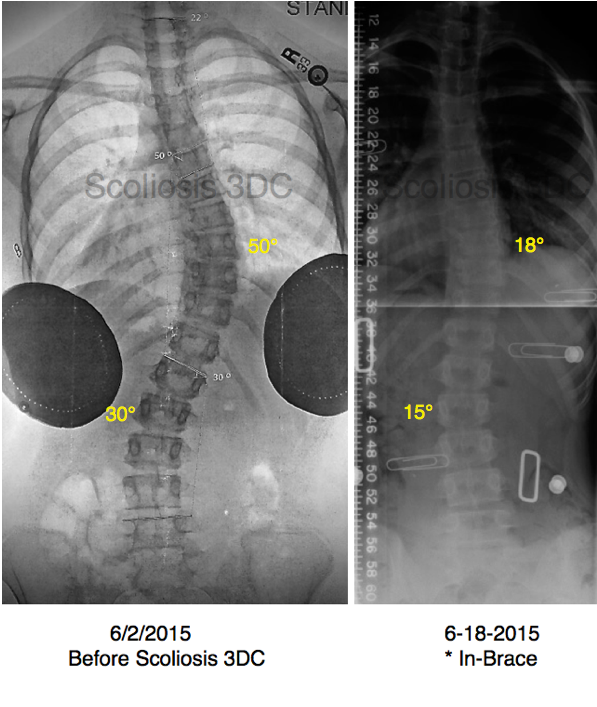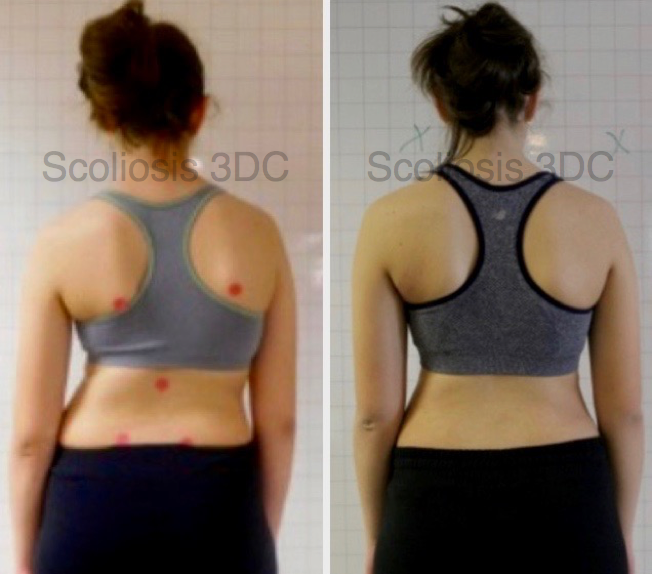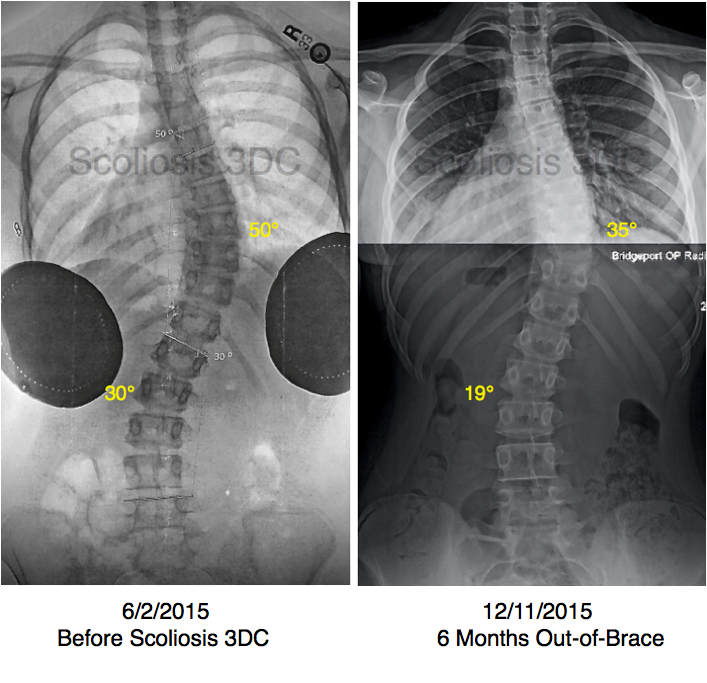
In-brace correction is a key component of scoliosis bracing. This can play a pivotal role in whether or not scoliosis brace treatment has the potential to be successful. Other factors, such as spinal flexibility, spinal curve pattern, Risser sign/stage, Cobb angle(s) degree at the start of bracing, and of course, patient compliance, will also factor into a patient’s outcome at the end of scoliosis treatment.
The in-brace correction effect (or, what percentage does the brace improve the Cobb angle while the patient is wearing the brace?) will vary by brace and the individual wearing the brace. It is also influenced by some of the factors mentioned above. The x-rays to the right demonstrate an in-brace correction of 64% in the thoracic spine and 50% in the lumbar spine for our 13-year-old adolescent patient with idiopathic scoliosis.
The evolution to Chêneau-style bracing now provides adolescents in the US with the potential for improved results at the end of scoliosis treatment when they are compliant with a well-designed Chêneau brace. Each brace should be fit to an exacting standard so the patient can wear the brace to feel pressure in specific areas, but never pain. In our opinion, a well-designed brace should strive to reduce the angles of scoliosis AND improve posture in an adolescent (due to the 3D design) rather than just halt progression.
When fitting patients in their scoliosis brace, our goal is to achieve an in-brace correction of a minimum of 30% to 50% or more. Fortunately, many patients we’ve braced have achieved superior in-brace corrections. Much depends on individual spinal flexibility and where a patient is in terms of skeletal development.
For patients who begin their bracing experience in the mild to low-moderate range (say the 17º to upper twenty degree Cobb angle range), or for those with a particularly flexible spine, our goal, for them, is to achieve some degree of over-correction. By over-correction we mean that the spine shifts beyond the midline in the opposite direction to create a mirror image of the spine while the patient wears their brace). Often, there can be a correlation between in-brace correction and outcome.
Here at Scoliosis 3DC® we also offer bracing to those with severe scoliosis (50º or more). Typically, most spinal surgeons will begin recommending fusion surgery for growing children whose Cobb angles reach about 45°-50°. Parents are often told that surgery is the only option available at that juncture. The Connecticut patient whose scoliosis x-rays are shown above was diagnosed with a 50° thoracic curve and told that she should have surgery, right away. Despite this recommendation, her parents found us online and decided to bring her to see us. She began her treatment regimen with Chêneau bracing and a returned a few months later to participate in our intensive Schroth method program complete with the add-ons we’ve incorporated which include activities of daily living, sagittal plane exercises, and mobilizations.
After less than a year, her spinal curves measured 35° thoracic and 19° lumbar when out of the brace for 24 hours (this is important, being x-rayed right out of the brace does not provide an accurate image of where the spine is). Since first coming to see us, in these pictures this pleasant teenager had grown 1” – meaning she has successfully managed to reduce her scoliosis during a growth spurt, a time when most kids with scoliosis are progressing! Her posture also improved noticeably – proving that it is possible to effectively treat scoliosis without surgical intervention.


We understand what families go through when a child is diagnosed with scoliosis because it happened to us. We’ve made it our life’s work to learn the most effective scoliosis management techniques and to bring those to others in an efficient way so kdis can control or even improve scoliosis and avoid progression. Managing scoliosis doesn’t need to be a mystery!
Oh, click here to see this patient’s final result…

